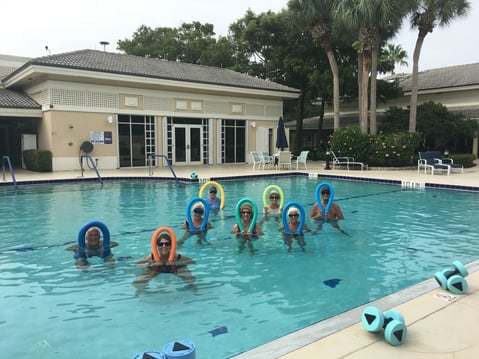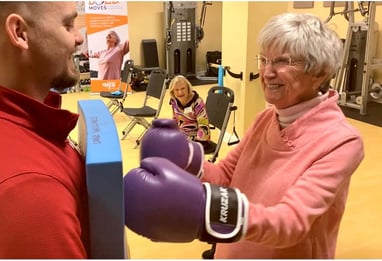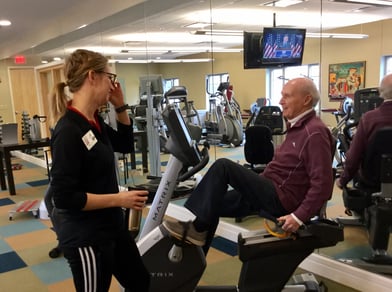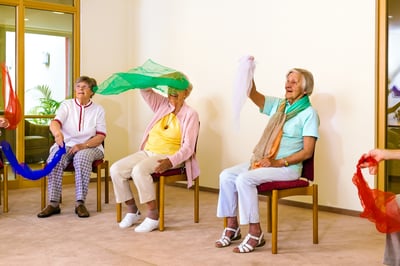 When you were a kid, going out to play was something you likely did every day. No matter if it was riding a bike, skipping rocks at the pond, or running around the neighborhood with friends, it was just fun! Moving came naturally and easy and was not considered “exercise” to the adolescent mind even though it was most certainly keeping your body healthy. The reason I bring this up is because I want you to think about those times. They were a lot of fun, weren’t they? Sometimes in our fitness center, we will hear a member say that exercise isn’t very fun. We get it! Exercise isn’t everyone’s cup of tea, but as a fitness professional, my goal is to find a way to make it fun for you. Another thing we will often here is “I’m not as young as I was!” or “I can’t do that type of movement anymore.” It is true, with the play you did as a child, there was probably a lot of falling, bumps, and bruises and that can make a person apprehensive to get started in “play” again. But that is why we are here, to explore with you and find a form of fitness that you enjoy. Yes, the several number of changes that tend to happen to the body as it goes through the stages of life can make some things more difficult, but we want to help keep it from being the reason you decide to play less.
When you were a kid, going out to play was something you likely did every day. No matter if it was riding a bike, skipping rocks at the pond, or running around the neighborhood with friends, it was just fun! Moving came naturally and easy and was not considered “exercise” to the adolescent mind even though it was most certainly keeping your body healthy. The reason I bring this up is because I want you to think about those times. They were a lot of fun, weren’t they? Sometimes in our fitness center, we will hear a member say that exercise isn’t very fun. We get it! Exercise isn’t everyone’s cup of tea, but as a fitness professional, my goal is to find a way to make it fun for you. Another thing we will often here is “I’m not as young as I was!” or “I can’t do that type of movement anymore.” It is true, with the play you did as a child, there was probably a lot of falling, bumps, and bruises and that can make a person apprehensive to get started in “play” again. But that is why we are here, to explore with you and find a form of fitness that you enjoy. Yes, the several number of changes that tend to happen to the body as it goes through the stages of life can make some things more difficult, but we want to help keep it from being the reason you decide to play less.
A regular physical activity regimen allows older adults to maintain independence as they age and navigate their way through life. The recommended goal for older adults is at least 150 minutes a week (that’s only 30 minutes of movement each day!) of moderate intensity aerobic exercise with two of those days being some type of muscle strengthening activity to improve muscle and bone health. All exercise is beneficial, but when we start aging, the most beneficial type of program would be one consisting of balance, flexibility, strength, and endurance. An equal mixture of all four and over time can provide drastic improvement in your everyday life activities as well as the overall health of your body.
Think back to younger years when stretching before and after physical activity wasn’t a thing, what were some of your favorite activities? Did you play cops and robbers with your friends, jump and splash in the pool with siblings, or play sports with friends? What are similar alternatives?
Did you really love running cross country track because it allowed you to get outside and see nature, that could now be substituted for going on weekly peaceful hikes with your family or friends. Explore local nature reserves and trails!
Did you like heading to the community pool or pond for a day with friends? Join your nearby fitness center and check out aqua classes or invite a friend to water walk!
Did you enjoy tennis? Consider taking up pickleball! A very similar game to tennis with less court to travel requiring less intense hits to get the ball across the net.
Did you belong to a bowling league? Believe it or not, virtual (Wii) bowling can be just as fun and competitive while also challenging your balance and stability!
Of course, we also suggest starting with your fitness professional! Talk to them about what you enjoy and what you don’t about exercise. We can help find ways to make it fun while increasing stamina and strength to enjoy “playing” more! Don’t forget that physical activity over time can improve quality of life and can increase longevity while decreasing other conditions that may come up. If it has been a while since you have exercised, that is okay! If you can make exercising social and fun, it can become something you love doing which helps to stay motivated instead of feeling like a chore.


 The prevalence of Parkinson’s Disease is on the rise. Previous numbers indicated that 60,000 Americans are diagnosed each year and
The prevalence of Parkinson’s Disease is on the rise. Previous numbers indicated that 60,000 Americans are diagnosed each year and 
 Consider how you can have a more inclusive environment in your IL fitness amenities
Consider how you can have a more inclusive environment in your IL fitness amenities
 While we've seen significant progress in what exercise can look like for residents in independent living (IL), for many communities, there remains something of a disconnect in making sure residents throughout the continuum of care have access to the same or similarly robust services and amenities.
While we've seen significant progress in what exercise can look like for residents in independent living (IL), for many communities, there remains something of a disconnect in making sure residents throughout the continuum of care have access to the same or similarly robust services and amenities. 